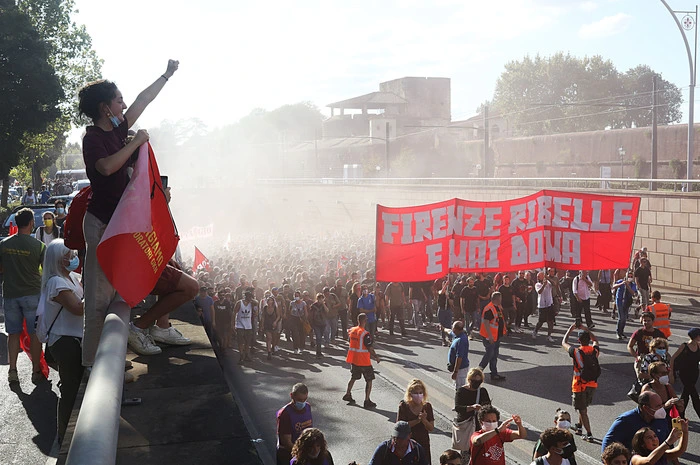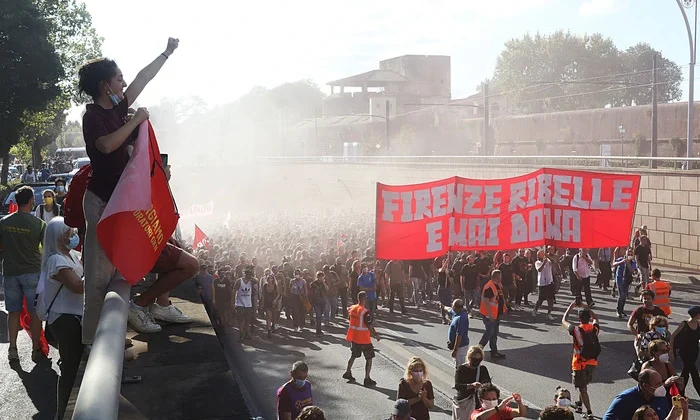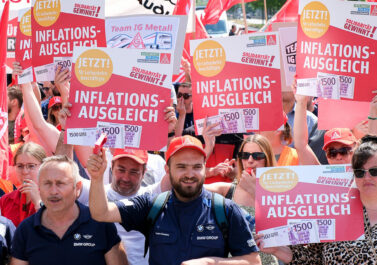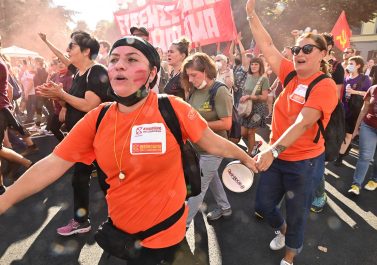
We’ve written before about the outstanding struggle of workers at the automotive parts manufacturer GKN in Italy. The following article summarises some of the more recent developments in the dispute. There is a real danger of the struggle becoming isolated and the workers becoming increasingly dependent on investment promises from both government and employers.
Up to now, the workers were formidable in avoiding the two main traps when it comes to disputes around a factory closure:
a) a strategy often endorsed by the ultra-left which reduces the struggle to squeezing as much money out of the bosses in compensation for the lost jobs. Even if this is done in militant ways – such as boss-napping, or by threatening to blow up the factory – in the end this is not a struggle ‘against work’, but a monetisation of workers collectivity that is willing to swap years of relationships and cooperation for money.
b) the trajectory of self-management, or an attempt to save the workforce at all costs by presenting viable business models; as a result workers tend to lose the backing of the wider class as a focal point of struggle, and end up as yet another example of alternative self-exploitation.
No one can explain better how, at least up to now, the GKN struggle avoided both these common deadends. We encourage you to watch this video by one of the GKN workers, which is a prime example of an organic working class programme.
On the 7th November 2022, various rank-and-file unions supported a call for a 24 hour regional strike in support of the factory occupation. These strikes will have to be backed up with concrete measures of re-appropriation and ‘proletarian taxation’ of local bosses and members of the upper class in order to finance the survival of the GKN struggle. The productive intelligence of the GKN workers has to be supported by an organised enforcement of a working class legality against the bosses’ law.
——
Hundreds of workers at the Campi Bisenzio factory that closed a year and a half ago are still waiting for solutions, and have been without pay for two months.
By Angelo Mastrandrea, Il Post, 4th December 2022
Sixteen months after its sudden closure, 320 workers at GKN – an auto mechanical components factory in Campi Bisenzio, about 20 kilometres from the centre of Florence – still have an organised presence at the plant, day and night. Near the entrance gate they have set up a tent that serves as a meeting point. Inside the factory, the former administrative offices are used for union meetings or as a storage place for flags, banners, drums, leaflets and some sweatshirts with the words ‘Factory Collective’. At lunchtime the cafeteria is buzzling with workers and activists arriving from all parts of Italy in a kind of militant pilgrimage, attracted by the duration of a workplace occupation that has already surpassed those of the Apollon printing works in Rome, between June 1968 and July 1969, and the Officine Meccaniche Reggiane, between October 1950 and the same month in 1951.
GKN Driveline is the world’s largest manufacturer of mechanical transmission systems that transfer power from the engine to the car’s wheels. The GKN factory in Tuscany produced mainly half-axis components, composed of steel rods that are connected to the drive shafts of the wheels. Until 1994, the factory was owned by Fiat, which then sold it to GKN, while remaining the main buyer of parts produced in Campi Bisenzio. All went well until the onset of the Covid pandemic. In 2021, car sales fell by nearly a quarter compared to 2019, and GKN decided to close the Tuscan plant, keeping only the one in Brunico, South Tyrol, Italy.
In a letter announcing the redundancies of 335 workers, 67 clerks, 16 managers, and four executives, the company explained that due to the crisis in the automotive market, the Campi Bisenzio plant’s sales in 2025 would reach 71 million euros – 48 percent lower than in 2019. Therefore, “the prospect is that of the plant not being sustainable.” According to the trade unions FIOM-CGIL, which filed an urgent appeal with the labour court in Florence, the decision had nothing to do with the crisis in the auto sector, but was dictated by a decision to produce axle shafts for Stellantis, formerly Fiat, in Eastern Europe rather than Italy.
The workers have been in a ‘permanent assembly’ since the 9th of July 2021, when the company – which since 2018 has been owned by the British private equity fund Melrose – sent them an email notifying them of the start of dismissal proceedings. They did not stop their protest mobilisation when Francesco Borgomeo took over the company on the 23rd December 2021, with plans to convert the plant into a site for the construction of electric motors.
Borgomeo, who studied philosophy at the Pontifical Gregorian University in Rome, is president of Unindustria Cassino, an employers’ association. He is an entrepreneur who consults for multinationals and specialises in industrial restructuring. He buys factories in liquidation, puts together conversion plans, and seeks investors in global markets and public financing. He had already taken over two ceramics factories, the former Marazzi in Anagni (Frosinone), and Tagina in Gualdo Tadino (Perugia), in both cases finding investors from abroad. In 2018, he restarted Ideal Standard in Roccasecca, in the province of Frosinone, converting it from the production of bathroom fixtures to that of cobblestones, made from a mixture of porcelain stoneware and municipal waste ash from incinerators. There he formed a new company, Saxa Grestone, finding four financial partners and investing 10 million euros out of his own pocket. Another 16 million was put in by the Ministry of Economic Development through its subsidiary Invitalia, 4 million by the Lazio region, and 10 million was left by Ideal Standard as compensation for abandoning the factory.
On the 21st October 2018, he recounted the rescue of Ideal Standard at the Leopolda convention in Florence organized by Matteo Renzi. He appeared on stage with a cobblestone made in the Roccasecca factory, explaining that it was an example of circular economy, “the real industrial revolution that we must ride… I have always liked to think of my companies as an open kitchen: everyone must know what is being prepared,” he said in an interview with the Catholic weekly Credere.
At GKN he tried to do the same thing. He formed a new company, Quattro F (QF), which stands for ‘Confidence in the Future of the Florence Factory’. To the Ministry of Economic Development and the unions, he presented a five-step rescue plan, from bringing in new shareholders by March to starting production in 2023 and reinstating all workers by 2024. The company was acquired at no cost, and in the 2021 budget, revenues include 25 million euros (presumably paid by the Melrose fund) “compensation awarded to the company for the interruption of production,” according to a report dated 6th of December. “On the day of the transfer of ownership, Borgomeo told us that we could go home now because everything was resolved and we could rest easy, that he would employ private security guards to protect the plant and call us back when everything was ready,” says Matteo Moretti, who has been a union delegate at the factory for 14 years.
This time, however, the recovery failed. No concrete offers came from either foreign or Italian investors. Borgomeo argued that this was because of the difficulty in taking possession of the factory, which was ‘illegally’ occupied, and because of the government’s failure to provide subsidies.
Instead, the workers blame the failure on the lack of a credible business plan capable of attracting investment and convincing the Ministry of Labor to grant the normal benefits of the ‘cassa integrazione’ [benefit payments for dismissed workers]. So they are still here, on a rainy November day, guarding the factory to prevent anyone from showing up to empty the warehouses or dismantle the machinery.
The last attempt to empty the factory was made on the 7th of November 2022. That morning, around 8 a.m., workers were told that QF trucks would arrive to clear “scrap and trash” from the company. Instead, workers feared that the company would begin emptying the plant and they prepared to prevent access to the factory. This was not the first time this had happened: in May, two strangers had shown up at the plant, later identified by workers as GKN representatives who had arrived from the Italian headquarters in Brunico, South Tyrol, and the Spanish headquarters in Vigo. In early July Stellantis, one of GKN’s largest customers, had demanded the delivery of machinery and car components worth eight million euros, particularly drive shafts, stored in the 80,000 square meters of factory yard and warehouses. In both cases, workers had prevented the material and machinery from being taken away.
On the morning of the 7th of November, however, the trucks were not to be seen. QF issued a note in which it claimed that “there were no minimum safety guarantees to carry out the planned activities” and that “the plant is squatted and illegally operated.” According to the workers, this was just a pretext to get them to leave the factory. “The truth is that they want to go on without us,” says Alessandro Tapinassi, one of the oldest of the workers. “It is very clear to us that if we leave the factory, we will never go back to work,” Moretti concludes. Two days later, QF stopped advancing layoff payments to workers, as it had done before in previous months. QF only paid wages to about 40 employees who are actually still working, mainly on maintenance activities, and whose number is in further decline.
Borgomeo himself declared publicly that the Ministry of Labor had not granted the former GKN the ordinary layoff funds, which include a monthly allowance of 900 euros paid by the INPS [National Institute of Social Security] to each worker who is employed by companies in economic difficulties. These redundancy payments were only granted for ten weeks, from the beginning of January to mid-March 2022, to allow for a restart after the factory was bought by the Melrose Fund. The continuation of the payment was conditional on the presentation of a business plan, which never arrived. In Borgomeo’s view, the biggest obstacles to restarting the company would be the absence of financial support from the state and the workers’ occupation of the factory.
The unions, on the other hand, think that the Ministry of Labor assessed that there was no basis for a reopening. “The layoff fund was not granted because there is no concrete project of reindustrialisation,” says FIOM-CGIL Secretary Daniele Calosi.
In the summer it seemed that the situation at GKN was moving toward a positive solution. On the 28th of July, a consortium of companies was formed to invest in the former GKN. The new consortium called Iris Lab was composed of QF and five other Italian companies: Itema, Bonfiglioli, Lafert, Sumitomo Group, and Faist Electronics.
On the 31st of August the consortium was supposed to meet at the Ministry of Economic Development to formalise the proposal. Instead, only Borgomeo showed up, who explained that reindustrialization would be carried out only by QF and that for this “the possibility of using the support of the governmental layoff fund is fundamental.” According to the minutes of the meeting, Luca Annibaletti, the coordinator of the Ministry’s Institute for companies in economic crisis, “recalled… that for the granting of the redundancy payments, it is necessary for QF to present a detailed industrial plan, which would allow its compatibility with the required employment support measures to be verified. Therefore, it called on the company to submit an industrial plan that fully illustrates the stages of the reindustrialization project, also specifying the relevant resources.” The plan was not submitted and the layoff funds were not granted.
The workers are now exasperated and no longer believe in promises. At the last crisis meeting convened on the 3rd of November at the former Ministry of Economic Development, which in the meantime has become the Ministry of Business and Made in Italy, the leading official Annibaletti asked for “a change in the governance of the company and the appointment of an independent advisor [a financial advisor, ed.] to be shared with the trade unions,” so as to “guarantee transparency and a procedure for selecting possible new investors.” Borgomeo, the minutes state, accepted the proposal. The workers asked for “support from the government, through the entering of Invitalia or another public entity into the corporate structure of QF, to guarantee the industrial future and the revitalization of the site.” At the moment, […] the chances of redeveloping the factory appear slim.
In the meantime, the workers have started legal proceedings against the company for defaulting on financial obligations, demanding payment of the statutory redundancy payments according to the layoff fund or, alternatively, the payment of full wages, as the Melrose fund had done until December 2021. They were paid full wages after the collective dismissal procedure, which had been announced on the 9th of July 2021, was annulled the following 20th of September by the labour judge Anita Maria Brigida Davia in Florence due to “violation of union rights.”
On Monday, 14th of November 2022, former GKN workers occupied the city council in Florence. About 30 of them stayed in the Hall of the Two Hundred in Palazzo Vecchio all night. They were asking Mayor Dario Nardella, of the Democratic Party, to do as his predecessor Giorgio La Pira did, who in 1953 sided with the workers laid off by Pignone and succeeded in convincing the president of the Italian energy company ENI Enrico Mattei to buy the company, converting it from the production of textile looms to machines for the oil and natural gas industry. “We are not just here for the payment of outstanding wages, but to take a real step forward,” the workers said. “We are trying to pursue our own recovery project, but we should have the possibility to use the factory space, at least temporarily,” explained Dario Salvetti, another union delegate.
With the support of a group of economists from the Scuola Superiore Sant’Anna in Pisa, the workers have developed a reconversion project that includes the production of mechanical components for local public transport electric buses, with a view to a “public hub of sustainable mobility.” Nardella sympathised with the workers, wrote a letter to Made in Italy Minister Adolfo Urso inviting him to visit the plant, and said it is necessary “to find new investors who can put new industrial plans on the table.”
To “stabilise income” the workers have formed a Mutual Aid Society, a corporate form provided for in the Civil Code that aims to provide “economic contributions and assistance services to members who find themselves in a condition of very serious economic hardship as a result of the sudden loss of personal and family sources of income and in the absence of public provision.” Salvetti explained this on the evening of the 21st of November to the 400 people who arrived in front of the factory to follow a public assembly called by the workers in order to “break the siege.” The entire Florence city council, invited by the workers to hold an extraordinary meeting at the factory, was expected to arrive.
Chairman Luca Milani of the Democratic Party, a former metalworker, had agreed, but in the end the centre-right opposed it and to avoid controversy the extraordinary council moved to Palazzo Vecchio. At the end, councillors approved an agenda asking local banks to advance payments to workers. In front of the factory, workers complained that December “will be the second month without income.” If the money does not arrive, “it will be like sending us a dismissal letter again.” “It’s a sneaky way to push us out,” Moretti says.
At the end of the meeting, the Factory Collective announced an open consultation with local citizens from the 1st to the 11th of December to decide the future of GKN. “The only alternative is between, on one side, the private sector that is blackmailing the public to get money hand over fist and socialise losses, and, on the other side, a factory with public intervention, public utility, public control and socially integrated to serve the wider community”.



